CERTIFICATION
RECOGNITION






The
water
penetration
test
was
conducted
on
an
unfinished
100mm
moladi
wall
which
was
exposed
to
an
apparatus
which
replicates
rainfall
conditions
equivalent
to
an
annual
rainfall
of
1000mm
per
annum
in
conjunction
with
a
wind
speed
of
30
metres
per
second.
The
rainfall
conditions
are
based
on
that
of
the
city
of
Cape
Town,
which
has
the
most
severe
rainfall
recordings
in
South
Africa.
The
wall
was
exposed
to
the
rainfall
apparatus
over
a
consecutive
24
hour
period.
It
was
concluded
that
moladi
walls
are
certified
as
waterproof
as
it
was able to remain impervious to exposure of the harsh rainfall conditions for the entire 24 hour period.






The
soft
body
impact
test
was
carried
out
on
an
unfinished
100mm
moladi
wall
which
was
subjected
to
a
collision
from
a
30kg
sandbag
at
various
velocities.
The
sandbag
was
attached
to
a
pendulum-like
apparatus
and
released
from
a
swing
height
of
900mm
to
test
the
serviceability
criteria
of
a
moladi
wall.
Thereafter,
the
sandbag
was
released
from
a
swing
height
of
1800mm
above
the
point
of
impact
in
order
to
test
the
safety
criteria
of
a
moladi
wall.
After
each
collision
the
wall
was
thoroughly
inspected
to
assess
damage
sustained
by
the
moladi
wall, such as collapse, cracking, superficial damage or depressions. It was recorded that no damage
was
sustained.





The
chisel
impact
test
was
carried
out
on
an
unfinished
100mm
moladi
wall
which
was
subjected
to
two
consecutive
strikes
of
a
chisel
at
a
very
high
velocity.
The
chisel
was
released
from
a
height
of
375mm
above
the
unfinished
floor
level
to
test
the
strength
and
impact
resistance of a
moladi
wall. A slight indentation of less than
3mm
just
above
the
chisels
point
of
impact
was
recorded.




AGRÉMENT SA
PANAMA GN
NHBRC SA
SABS
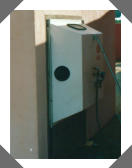
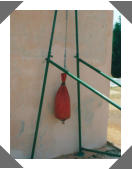
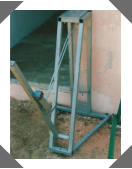



STANDARD BANK
FIRST NATIONAL BANK
ABSA BANK

ADDRESS
PO Box 16553
Emerald Hill
Port Elizabeth
South Africa
6011
Copyright reserved © Terms of use apply

NAVIGATION
SOCIAL
CERTIFICATION
RECOGNITION


















The
water
penetration
test
was
conducted
on
an
unfinished
100mm
moladi
wall
which
was
exposed
to
an
apparatus
which
replicates
rainfall
conditions
equivalent
to
an
annual
rainfall
of
1000mm
per
annum
in
conjunction
with
a
wind
speed
of
30
metres
per
second.
The
rainfall
conditions
are
based
on
that
of
the
city
of
Cape
Town,
which
has
the
most
severe
rainfall
recordings
in
South
Africa.
The
wall
was
exposed
to
the
rainfall
apparatus
over
a
consecutive
24
hour
period.
It
was
concluded
that
moladi
walls
are
certified
as
waterproof
as
it
was
able
to
remain
impervious
to
exposure
of
the
harsh
rainfall conditions for the entire 24 hour period.
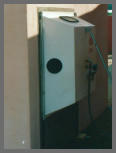
The
soft
body
impact
test
was
carried
out
on
an
unfinished
100mm
moladi
wall
which
was
subjected
to
a
collision
from
a
30kg
sandbag
at
various
velocities.
The
sandbag
was
attached
to
a
pendulum-like
apparatus
and
released
from
a
swing
height
of
900mm
to
test
the
serviceability
criteria
of
a
moladi
wall.
Thereafter,
the
sandbag
was
released
from
a
swing
height
of
1800mm
above
the
point
of
impact
in
order
to
test
the
safety
criteria
of
a
moladi
wall.
After
each
collision
the
wall
was
thoroughly
inspected
to
assess
damage
sustained
by
the
moladi
wall,
such
as
collapse,
cracking,
superficial
damage
or
depressions.
It
was
recorded that no damage
was
sustained.
The
chisel
impact
test
was
carried
out
on
an
unfinished
100mm
moladi
wall
which
was
subjected
to
two
consecutive
strikes
of
a
chisel
at
a
very
high
velocity.
The
chisel
was
released
from
a
height
of
375mm
above
the
unfinished
floor
level
to
test
the
strength
and
impact
resistance
of
a
moladi
wall.
A
slight
indentation
of
less
than
3mm
just
above
the
chisels
point
of
impact
was
recorded.
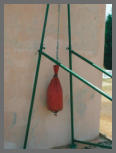
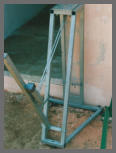

ADDRESS
PO Box 16553
Emerald Hill
Port Elizabeth
South Africa
6011
Copyright reserved © Terms of use apply
NAVIGATION
SOCIAL





























